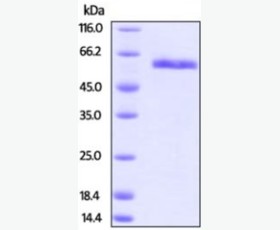Recombinant Human Ubiquitin-Conjugating Enzyme E2 A/UBE2A
| Product name: | Recombinant Human Ubiquitin-Conjugating Enzyme E2 A/UBE2A |
| Source: | E.coli |
| Purity: | Greater than 95% as determined by reducing SDS-PAGE. |
| Buffer Formulation: | Supplied as a 0.2 μm filtered solution of 50mM HEPES, 150mM NaCl, 2mM DTT, 10% Glycerol, pH 7.5. |
| Applications: | Applications:SDS-PAGE; WB; ELISA; IP. |
| Storage: | Avoid repeated freeze/thaw cycles. Store at 2-8 oC for one month. Aliquot and store at -80 oC for 12 months. |
| UOM: | 100ug/50ug/200ug/1mg/1g |
| Source | E.coli |
| Description | Recombinant Human Ubiquitin-Conjugating Enzyme E2 A is produced by our E.coli expression system and the target gene encoding Met1-Cys152 is expressed with a GST, 6His tag at the N-terminus. |
| Names | Ubiquitin-Conjugating Enzyme E2 A, RAD6 Homolog A, HR6A, hHR6A, Ubiquitin Carrier Protein A, Ubiquitin-Protein Ligase A, UBE2A, RAD6A |
| Accession # | P49459 |
| Formulation | Supplied as a 0.2 μm filtered solution of 50mM HEPES, 150mM NaCl, 2mM DTT, 10% Glycerol, pH 7.5. |
| Shipping |
The product is shipped on dry ice/ice packs. |
| Storage |
Store at < -20°C, stable for 6 months after receipt. Please minimize freeze-thaw cycles. |
| Purity |
Greater than 95% as determined by reducing SDS-PAGE. |
| Endotoxin | Less than 0.1 ng/µg (1 IEU/µg) as determined by LAL test. |
| Amino Acid Sequence |
MSPILGYWKIKGLVQPTRLLLEYLEEKYEEHLYERDEGDKWRNKKFELGLEFPNLPYYIDGDVKL TQSMAIIRYIADKHNMLGGCPKERAEISMLEGAVLDIRYGVSRIAYSKDFETLKVDFLSKLPEML KMFEDRLCHKTYLNGDHVTHPDFMLYDALDVVLYMDPMCLDAFPKLVCFKKRIEAIPQIDKYLKS SKYIAWPLQGWQATFGGGDHPPKSDGSTSGSGHHHHHHSAGLVPRGSTAIGMKETAAAKFERQHM DSPDLGTGGGSGDDDDKSPMGSTPARRRLMRDFKRLQEDPPAGVSGAPSENNIMVWNAVIFGPEG TPFEDGTFKLTIEFTEEYPNKPPTVRFVSKMFHPNVYADGSICLDILQNRWSPTYDVSSILTSIQ SLLDEPNPNSPANSQAAQLYQENKREYEKRVSAIVEQSWRDC
|
| Background | Ubiquitin-Conjugating Enzyme E2 (UBE2A) is a member of the E2 Ubiquitin-Conjugating Enzyme family. The modification of proteins with ubiquitin is an important cellular mechanism for targeting abnormal or short-lived proteins for degradation. Ubiquitination involves at least three classes of enzymes: ubiquitin-activating enzymes, or E1s, ubiquitin-conjugating enzymes, or E2s, and ubiquitin-protein ligases, or E3s. UBE2A catalyzes the covalent attachment of ubiquitin to other proteins. UBE2A is required for postreplication repair of UV-damaged DNA. UBE2A Interacts with RAD18 and WAC. |














